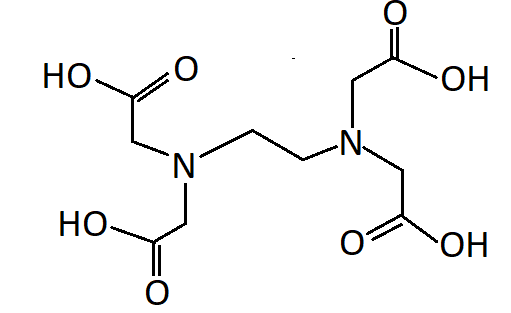
Answer
444.9k+ views
Hint:Ligands are atoms or groups of ligands that bind to a central metal atom to form a coordination complex. The nature of this ligand-metal bond can be ionic or covalent. Some ligands can form more than one bond with the metal atom, these are known as polydentate ligands.
Complete step by step answer:
-Denticity refers to the number of donor groups in the single ligand that can form bonds with the central metal atom.
- Ligand which has only one donor atom is called monodentate ligands, ligands having two donor atoms are called a bidentate ligand.
-DMG stands for Dimethylglyoxime. It binds with metal atoms with two bonds one with each nitrogen atom. Hence it is a bidentate ligand.

-Similar to DMG, ethylenediamine also has two nitrogen atoms as donor atoms and is a bidentate ligand.
${{{H}}_{{2}}}{{N - C}}{{{H}}_{{2}}}{{ - C}}{{{H}}_{{2}}}{{ - N}}{{{H}}_{{2}}}$
-Similarly, a ligand having six donor atoms is called a hexadentate ligand.
-EDTA refers to ethylenediaminetetraacetic acid. EDTA has two nitrogen atoms and four oxygen atoms as donor atoms. Thus it is a hexadentate ligand

Hence the correct option is A. EDTA is a hexadentate ligand.
Note:
EDTA imparts extra stability to the coordination complex due to its chelate effect.
Chelation is the property of polydentate ligands which means ligands that have more than one donor atom.
When a polydentate ligand bonds with the central metal atom or ion, it forms a ring. This ring formation because of the presence of more than one donor atoms is called chelation.
The ring formation or chelation enhances the stability of the coordination complex as compared to the one having no chelation, this effect is known as the chelate effect.
Complete step by step answer:
-Denticity refers to the number of donor groups in the single ligand that can form bonds with the central metal atom.
- Ligand which has only one donor atom is called monodentate ligands, ligands having two donor atoms are called a bidentate ligand.
-DMG stands for Dimethylglyoxime. It binds with metal atoms with two bonds one with each nitrogen atom. Hence it is a bidentate ligand.

-Similar to DMG, ethylenediamine also has two nitrogen atoms as donor atoms and is a bidentate ligand.
${{{H}}_{{2}}}{{N - C}}{{{H}}_{{2}}}{{ - C}}{{{H}}_{{2}}}{{ - N}}{{{H}}_{{2}}}$
-Similarly, a ligand having six donor atoms is called a hexadentate ligand.
-EDTA refers to ethylenediaminetetraacetic acid. EDTA has two nitrogen atoms and four oxygen atoms as donor atoms. Thus it is a hexadentate ligand

Hence the correct option is A. EDTA is a hexadentate ligand.
Note:
EDTA imparts extra stability to the coordination complex due to its chelate effect.
Chelation is the property of polydentate ligands which means ligands that have more than one donor atom.
When a polydentate ligand bonds with the central metal atom or ion, it forms a ring. This ring formation because of the presence of more than one donor atoms is called chelation.
The ring formation or chelation enhances the stability of the coordination complex as compared to the one having no chelation, this effect is known as the chelate effect.
Recently Updated Pages
A very dilute acidic solution of Cd2+ and Ni2+ gives class 12 chem sec 1 JEE_Main

Calculate the equivalent resistance between A and class 12 physics JEE_Main

The potential difference between points A and B in class 12 physics JEE_Main

A wire is bent in the form of a triangle now the equivalent class 12 physics NEET_UG

For the circuit shown in figure the equivalent capacitance class 12 physics JEE_Main

If on applying the potential of 20 V on a conductor class 12 physics JEE_Main

Trending doubts
Which are the Top 10 Largest Countries of the World?

What is the definite integral of zero a constant b class 12 maths CBSE

Differentiate between homogeneous and heterogeneous class 12 chemistry CBSE

Explain sex determination in humans with the help of class 12 biology CBSE

How much time does it take to bleed after eating p class 12 biology CBSE

Distinguish between asexual and sexual reproduction class 12 biology CBSE




